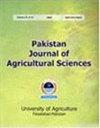Determining the nutrient content, relative feed value, and in vitro digestibility value of some legume forage plants
IF 0.6
4区 农林科学
Q3 AGRICULTURE, MULTIDISCIPLINARY
引用次数: 0
Abstract
The purpose of this study was to determine the feed values of some legume forage plants growing in a natural environment. The plant materials used in the study were as follows: Alfalfa (Medicago sativa), varigated alfalfa (Medicago varia), bird vetch (Vicia cracca), mountain vetch (Vicia alpestris), mountain clover (Trifolium montanum), kura clover (Trifolium ambiguum), three-headed clover (Trifolium trichocephalum), purple crownvetch (Coronilla varia), and bird’s foot trefoil (Lotus corniculatus). The feeds were examined in terms of nutrient content, relative feed value, true dry matter digestibility, true organic matter digestibility, true neutral detergent fiber digestibility, and relative feed quality. The legume forage plants were found to be significantly different from each other in terms of nutrient contents (P<0.05). The mountain clover was found to have the highest contents of crude protein and crude fat among the legume forage plants examined in this study, while the alfalfa was found to have more contents of dry matter and NDF than the other legume forage plants. On the other hand, the dry matter intake was found to be the highest in the three-headed clover, the dry matter digestibility and relative feed value were found to be the highest in the purple crownvetch, and the relative feed quality was found to be the highest in the mountain vetch. The nutrient contents, relative feed values, and relative feed quality values of the forage plants showed that they could be used in animal feeding.测定某些豆科牧草的营养成分、相对饲料价值和体外消化率
本研究的目的是确定在自然环境中生长的一些豆科饲料植物的饲料价值。本研究选用的植物材料为:紫花苜蓿(Medicago sativa)、杂花苜蓿(Medicago varia)、紫花苜蓿(Vicia cracca)、山紫花苜蓿(Vicia alpestris)、山三叶草(Trifolium montanum)、库拉三叶草(Trifolium ambiguum)、三头三叶草(Trifolium trichocephalum)、紫冠紫花苜蓿(Coronilla varia)、鸟脚三叶草(Lotus corniculatus)。从营养成分含量、相对饲料价值、真干物质消化率、真有机物消化率、真中性洗涤纤维消化率和相对饲料品质等方面进行试验。豆科饲料植物的营养成分含量差异显著(P<0.05)。结果表明,山三叶草粗蛋白质和粗脂肪含量最高,苜蓿干物质和NDF含量高于其他豆科饲料植物。干物质采食量以三头三叶草最高,干物质消化率和相对饲料价值以紫冠豇豆最高,相对饲料质量以山豇豆最高。饲料植物的营养成分含量、相对饲料价值和相对饲料品质值表明,它们可以用于动物饲养。
本文章由计算机程序翻译,如有差异,请以英文原文为准。
求助全文
约1分钟内获得全文
求助全文
来源期刊

Pakistan Journal of Agricultural Sciences
AGRICULTURE, MULTIDISCIPLINARY-
CiteScore
1.80
自引率
25.00%
发文量
18
审稿时长
6-12 weeks
期刊介绍:
Pakistan Journal of Agricultural Sciences is published in English four times a year. The journal publishes original articles on all aspects of agriculture and allied fields.
 求助内容:
求助内容: 应助结果提醒方式:
应助结果提醒方式:


